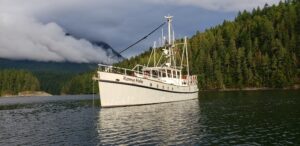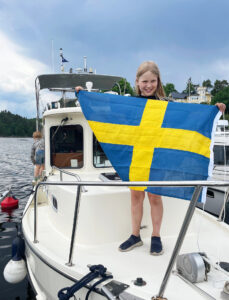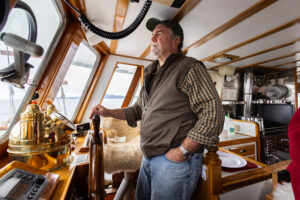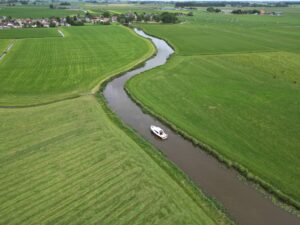Cruising the Intracoastal Waterway (ICW) from Virginia to Florida is a bucket list dream for many cruisers. While the prospect of making the trip of more than 1,000 nautical miles may seem daunting, it needn’t be intimidating. Essentially it is just a series of day trips, and each year thousands of cruisers make the run. Here are a few ideas to keep in mind to make planning and executing this trip easier.
If it helps, and it may not, you can think about navigating the ICW as a four-dimensional chess game. You monitor your boat east and west along the X axis while also monitoring your position north and south on the Y axis. You will have to deal with the Z axis, height, as well. You’ll need high water to transit shallow spots, and you may need low water levels to pass under certain bridges. The fourth dimension is time. In addition to managing your time in order to cross shoal areas with enough water depth, you must manage your approach to restricted bridges not only based on water height but also to ensure your passage is compatible with their opening schedule.
Traveling south in late fall, daylight lasts only 10 hours. To optimize the time, most cruisers have the lines in at “crack of dawn” (COD) and plan to be off the water with an hour or two of daylight left. This allows them to travel between 40 and 70 nautical miles each day. At that pace, completing the ICW would take three to four weeks, provided you do not stop. But that would be a grave mistake. There are so many interesting towns and villages on the way and several beautiful anchorages off the beaten path. Allow yourself time to enjoy the trip. Slow down. Slow down some more. You’ll be glad you did.
There are four components to successfully piloting the ICW: navigation, tides and currents, provisioning your boat, and the all-important weather.
Navigation
Coastal piloting and navigating has never been easier. Chartplotters, tablets, electronic features such as AIS, and near-constant access to the internet makes it far easier to move your boat along the coast. The following tools and protocols are essential to planning and executing this voyage safely.
Chartplotter/Tablet
While you can make the trip with paper charts, electronic charts are far easier to update. There are few places more dynamic than the section of the ICW through the Carolinas and Georgia, and you must have the latest charts in order to safely navigate this stretch. The USCG frequently moves navigation aids and NOAA updates the charts. In the ICW there are many areas where the marks are moved by the USCG as needed. It is easy to misread the navigation aids, particularly when they are not where you expect them to be.
Today’s tablets can serve as fully functioning chartplotters. Navionics’ Sonar Charts have proven to be very useful to us. These charts have updated depth readings from crowd sourced data collection.
The magenta line is not intended to be used as a chartplotter route! If you follow it as though it were, you will run aground.
Depth Finder
Be sure your depth finder is checked and calibrated. In some places, this trip is a game of inches.
Time to Waypoint (TTW)
Many chartplotters have this functionality. The “Auto Route” function in Navionics is very easy to use. The TTW will allow you to manage your approach to a bridge, lock, or a shoal spot so that you arrive at the desired time and spend minimal time circling in front of a bridge.

Cruising Guides
Whether you choose an online cruising guide or a print guide, cruising guides are written by other cruisers who have gone before. Guides generally reference the towns, bridges, and other sites by their statute mile distance from ICW “Mile 0” in Portsmouth, Virginia. A popular resource is Active Captain, but there are times to read a print guide. Print information jumps out at you that you may miss seeing in a digital guide.
Tides and Currents
Your chartplotter contains the NOAA database of the tides and currents. Many prefer to access this information through a phone or tablet. There is obvious benefit to knowing when the tidal height will help you through a shallow area. Less obvious is the benefit from access to current flow data. There are several places where the current runs very strong, such as Cape Fear River (STM 300), Elliot Cut (STM 472) , and Pablo Creek (STM 743). There are times you just want to wait an hour or two to let the head current subside.
Weather
It is not enough to get up in the morning and turn on the Weather Channel to get the day’s weather. At the end of the day you will be 50 to 80 miles from where you started. Your weather review must incorporate the predictions for your destination, too. If you are planning to bump out and spend a day running along the coast, there are several surfer sites (such as surfline.com) that are very good at predicting wave height and direction. This can be very handy information if you head out expecting two-footers from the northeast, but the actual wave pattern is four feet from the southeast. You could have a long miserable day with beam seas.
Managing Marinas on the ICW
There are thousands of boats moving during the fall migration. Marina slips can be at a premium. If you plan ahead three days, you can almost always secure a marina reservation. Marinas understand that there are many factors that affect your progress. So if you cannot make your reservation, call early and let them know. They can usually fill the space and will let you reschedule. Just don’t forget to call and be a “no show.” That makes the trip harder for all cruisers.
A marina stop generally allows you to refuel, pump out, do laundry, and maybe even use the loaner car to reprovision. As most cruisers pull into the marina around 3 p.m., this often results in a wait at the fuel dock or the pump-out station. Once in a slip you find that all the washing machines are filled and the loaner car is out. You will have to reprovision tomorrow. Thus, a marina stop becomes a two-day stay.
To cut your marina bills in half, plan your arrival at the marina for early in the day. The previous day’s transients will be underway and gone. The fuel dock will be open, the laundry machines will be free, and the loaner car will be available. You can get all your errands accomplished in one day, have a nice dinner ashore, and be underway the next day having spent only one night at the marina.

Tides and Currents at Marinas
In the Carolinas, Georgia, and North Florida, you will have to deal with some pretty strong currents. There is no shame in letting the marina know that you are going to wait for slack water to enter. A few years ago, we were entering Charleston. After the marina gave us our slip assignment, we felt that the currents were too strong. We advised the marina that we would wait until slack, so we went off to spend a few hours exploring the Cooper River.
Provisions
Whether you are looking for food, water, fuel, and/or a pump-out, you’ll find that access to these services is nearly continuous. Plan your stop for services on a day when the conditions, wind, weather, or tide is not in your favor.
Moving along the ICW, you can really only plan ahead about three days. It means planning for shoals and bridges at predicted times. You must be aware of impending weather hundreds of miles ahead. Attempting to plan further out becomes problematic due to the wide range of variable factors. It is important to always keep looking down the course. However, the miles you make today influence your options for tomorrow, and tomorrow’s destination will affect the plan for the following day. So planning more than a couple days out is time wasted.
The ICW is bookended by Virginia and Florida, two states that are simple to manage. The charts and tides are predictable and moderate. The charts are also accurate: In Virginia, the channels and rivers and bays seldom change. The ICW adds navigational challenges gradually as you move into North Carolina, however. The Carolinas and Georgia present certain challenges as these waterways are more dynamic. With shoaling in channels and new channels being scoured out, navigation aids get moved and reset. Strong currents and big tidal swings cause issues even for the prudent navigator. By the time you cross the St. Johns River (STM 740) you will have mastered the four-dimensional navigational challenges of the ICW.










